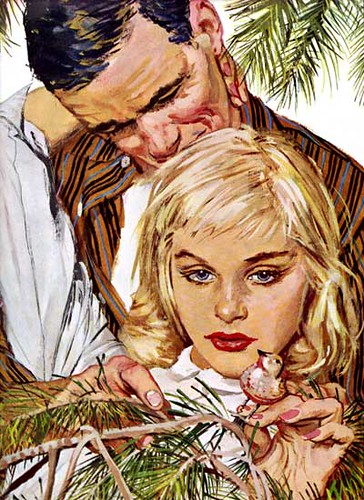If you asked me to describe Austin Briggs' work in one word, that would be it. I've yet to see a wishy-washy piece by Briggs. Even his tamest subjects have a sense of forboding about them. The guy could create tension by adding a certain twinkle in an eye or just the right curve in a brow. The young lady above is a perfect example.
Not by coincidence, I placed Briggs immediately after Alex Ross because he ( Briggs ) also had a connection to Alex Raymond. First he assisted Raymond on Secret Agent X-9 in 1936, then he apperently took over drawing the strip. The next part is a bit confusing... I've read conflicting reports that Briggs either created Flash Gordon but was not credited or ghosted Flash Gordon - then later drew the sunday strips while Raymond drew the weekday strips.
In any case, by 1948 he had left comics and comic strips and would spend the next 25 years as one of the most sought-after and successful artists in magazine and advertising illustration. Briggs was one of the senior faculty of the Famous Artists Correspondence School and is in the Society of Illustrators Hall of Fame. He died in Paris in 1973 of leukemia.
Celebrating illustration, design, cartoon and comic art of the mid-20th century.
Monday, December 05, 2005
Gutsy
Subscribe to:
Post Comments (Atom)

That's nice stuff. Very confident.
ReplyDeleteWish I could do storyboards like that....
I agree, Leif-- "Gutsy" is a great word to describe Briggs' style. His aesthetic confidence paved the way for a whole generation of illustrators, such as Bernie Fuchs,Mark English and Bob Heindel, all of whom revered Briggs. For his part, Briggs used to enjoy how the younger generation of talent kept nipping at his heels. He would see Fuchs, English and Heindel conspiring at the Society of Illustrators and he would call out, "Ahhh, the young Turks... always on my ass."
ReplyDeleteThat's very interesting, David... I know a lot of elements converged to create the stylistic evolution around the early sixties but I never considered that fearless experimenters with long lists of credits - like Briggs - might have inspired the "young turks", but of course it makes perfect sense.
ReplyDeleteI always assumed it was those young turks like Fuchs, Peak etc who forced the "Cooper School" to adapt or die.
Well, they certainly turned up the heat under the Cooper school crowd, that's for sure. I always thought that the Jon Whitcomb types were lightweights compared to the artists you mention.
ReplyDeleteBy the way, there is a hilarious story in the upcoming Illustration Magazine about the time that Austin Briggs first met Bernie Fuchs. Fuchs was a young kid from out of town, fresh off the pumpkin truck, and he stumbled into the middle of a feud between Briggs and Robert Fawcett. Suffice it to say that eventually everyone went back to being the best of friends.
I only just discovered Briggs, which is ironic, since not only do I love comics and illustration in general, but grew up in the area he was born in (he was born in Humboldt, Minnesota, where I graduated high school...)
ReplyDeleteIf you haven't already done so, Trish, please check out my Austin Briggs Flickr set
ReplyDeleteJust a theory, but:
ReplyDeleteIn addition to the gutsy experimentation of Briggs, Sickles, Fawcett, et al, I always thought that the advertising $$ leaving print for TV, and the readership dropping alarmed the editors at the magazines so much, that they started trying new things. I'm not sure, but I think that the editorial ilustration style got more interesting before advertising?? Any thoughts?
Ironically as illustration was starting to die throughout the 60's, the art directors started to finally let the illustrators experiment. I've always thought that more artists in the 40's and 50's could have done more creative work, but the business and culture were very restrictive.
Josh;
ReplyDeleteI think you're on the right track - though there were probably a lot of factors. Illustrators don't operate in a vacuum so their lack of experimentation earlier may have been simply a result of reflecting the sensability of the times of which they were a part. I think abstract expressionism was just emerging in a big way during the 50's, wasn't it? (my art history knowledge is sorely lacking) But anyways, until the public was ready for more experimental approaches, the illustrators of the day likely also weren't ready - nor the art directors, I suppose.
Though I'll tell you this: from my small stack of "Art Director and Studio news" magazines, I can see that, when speaking to their peers, those same ADs chose more experimental styles to decorate the covers of their trade magazine - and this was in '52, '53!